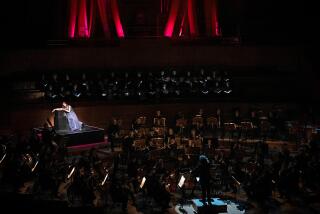MUSIC REVIEW : SILVERSTEIN PLAYS, CONDUCTS AT UCLA
- Share via
There certainly were no acoustic hazards to combat Sunday, the kind that can bring a string player to grief at the open-air Hollywood Bowl--usual scene of concerts by the Los Angeles Philharmonic Institute Orchestra.
This time the ensemble came indoors, to the hospitable Royce Hall at UCLA. And Joseph Silverstein, former concertmaster of the Boston Symphony, took advantage of his good fortune. Perhaps too much so.
As a visiting faculty member of the institute and with the blessings of artistic director Sir Charles Groves, Silverstein is presumably empowered to make the decision both to play and conduct Beethoven’s Violin Concerto. After all, he made his name as an instrumentalist and now has moved on to conducting the Utah Symphony. So in the interest of pedagogy, Silverstein was exercising a rightful option and offering up both his skills.
But the neat little trick of playing and conducting at the same time turns out to be a sham under the circumstances. As an 18th-Century custom linked to chamber-size resident ensembles that stayed together throughout a lifetime, yes. For a full-scale modern orchestra assembled for six weeks, hardly.
It’s bad enough to encounter this largely unworkable idea as foisted on professional bands--for them the prospect comes to just another dollar for another day. But the institute players, who are actually here to learn something after traveling far for the privilege, get a bum deal in the bargain.
For the Beethoven work, which occupied half the program, the players could act as nothing more than musical functionaries. Silverstein stood on the podium leading them intermittently, but when tending to his solo duties he turned to the audience and could offer little but a head nod.
It wasn’t enough.
The fact that the violinist could deliver tender expression in iridescent tones did not compensate for what was missing. Beethoven did have a complete work in mind. He called it a concerto, not a sonata for violin accompanied by distant, undifferentiated sounds.
Both of the evening’s conducting fellows--Alasdaire Neale and George Robert Hanson--put Silverstein to shame, after the intermission.
When the orchestra players stamped their feet for Neale at the conclusion of Stravinsky’s Symphony in Three Movements, the appreciation seemed understandable. Thanks to Stravinsky and the meticulous attention paid by Neale, they could finally enjoy a deserved challenge.
Here was the alert, vital playing of a superb ensemble led by one who knows his way around Stravinskyan complexities. Here were the bold, spiky assertions, the gentle jauntiness, the slight caricature, the sizzling exuberance.
Equally distinguished was Hanson’s traversal of Debussy’s “La Mer,” which seized the ear with lush sonorities and conjured up not only mood but the sense of structure, momentum, drama and climax so unconscionably lacking under Silverstein’s guidance.
More to Read
The biggest entertainment stories
Get our big stories about Hollywood, film, television, music, arts, culture and more right in your inbox as soon as they publish.
You may occasionally receive promotional content from the Los Angeles Times.










